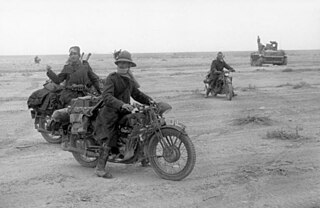
The 1st Army was a Royal Italian Army field army, in World War I, facing Austro-Hungarian and German forces, and in World War II, fighting on the North African front.

The Battle of Vittorio Veneto was fought from 24 October to 3 November 1918 near Vittorio Veneto on the Italian Front during World War I. After having thoroughly defeated Austro-Hungarian troops during the defensive Battle of the Piave River, the Italian army launched a great counter-offensive: the Italian victory marked the end of the war on the Italian Front, secured the dissolution of the Austro-Hungarian Empire and contributed to the end of the First World War just one week later. On 1 November, the new Hungarian government of Count Mihály Károlyi decided to recall all of the troops, who were conscripted from the territory of Kingdom of Hungary, which was a major blow for the Habsburg's armies. The battle led to the capture of over 5,000 artillery pieces and over 350,000 Austro-Hungarian troops, including 120,000 Germans, 83,000 Czechs and Slovaks, 60,000 South Slavs, 40,000 Poles, several tens of thousands of Romanians and Ukrainians, and 7,000 Austro-Hungarian loyalist Italians and Friulians.
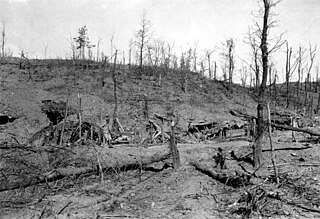
The Battle of Asiago(Battle of the Plateaux) or the Südtirol Offensive (in Italian: Battaglia degli Altipiani), nicknamed Strafexpedition ("Punitive expedition") by the Austro-Hungarian forces, was a major counteroffensive launched by the Austro-Hungarians on the territory of Vicentine Alps in the Italian Front on 15 May 1916, during World War I. It was an "unexpected" attack that took place near Asiago in the province of Vicenza (now in northeast Italy, then on the Italian side of the border between the Kingdom of Italy and Austria-Hungary) after the Fifth Battle of the Isonzo (March 1916).

The Battle of Mount Ortigara was fought from 10 to 25 June 1917 between the Italian and Austro-Hungarian armies for possession of Mount Ortigara, in the Asiago Plateau.

The 35 cm Marinekanone L/45 M. 16 was used by Austria-Hungary during World War I as a superheavy siege gun. Eleven of these had been ordered from Škoda Works before the war to equip the first unit of the Ersatz Monarch-class battleships that Austria had ordered. The ships were cancelled shortly after the outbreak of the war, but the guns continued in production.
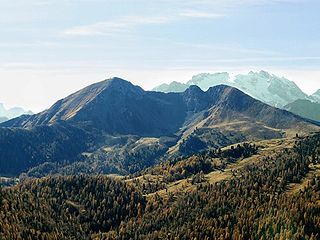
The Col di Lana is a mountain of the Fanes Group in the Italian Dolomites. The actual peak is called Cima Lana and situated in the municipality of Livinallongo del Col di Lana in the Province of Belluno, Veneto region.

The Legione Redenta was an Italian military formation that participated in the Siberian intervention during the Russian Civil War. It was formed from 2500 prisoners of war who had been captured by the Russians from the Austro-Hungarian Army.
Monte Cimone di Tonezza is a mountain of the Veneto, Italy. It has an elevation of 1,226 metres (4,022 ft).

Cima Palon, also called Monte Pasubio, is the highest peak of the Pasubio group of Little Dolomites in Veneto, Italy. It has an elevation of 2,239 metres.

The Strada delle 52 Gallerie, also known as the 52 Tunnel Road, or Strada della Prima Armata is a military mule road built during World War I on the Pasubio massif in Veneto, Italy.

The Vicentine Alps are a mountain range of the Eastern Alps in Trentino and the provinces of Verona and Vicenza. The mountains were named after the city of Vicenza which lies at their eastern edge. The highest point in the range is the Cima Dodici on the northern perimeter of the Vicentine Alps.

The Asiago War Memorial is a World War I memorial located in the town of Asiago in the Province of Vicenza in the Veneto region of northeast Italy. Surrounded by mountains that were the site of several World War I battles, the monument houses the remains of over 50,000 Italian and Austro-Hungarian soldiers and is a popular destination for travelers to the region. In Italian the memorial is typically called Sacrario Militare di Asiago or Sacrario Militare del Leiten. Leiten is the name of the hill on which the memorial sits.
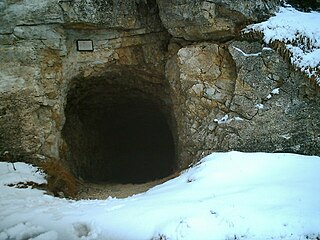
The mines on the Italian front during the First World War comprised a series of underground explosive charges of varying sizes, secretly planted between 1916 and 1918 by Austro-Hungarian and Italian tunneling units beneath their enemy's lines along the Italian front in the Dolomite section of the Alps.
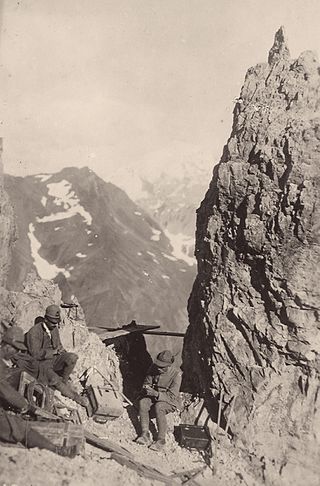
The Alpini are a specialised mountain warfare infantry corps of the Italian Army, which distinguished itself in World War I fighting in the Alps against Austro-Hungarian Kaiserjäger and the German Alpenkorps. The Alpini were supported by the Mountain Artillery, which both share the Cappello Alpino as identifying symbol. Below follow tables listing the regiments, battalions and groups, companies and batteries of the Alpini and Mountain Artillery active in World War I.

The White War is the name given to the fighting in the high-altitude Alpine sector of the Italian front during the First World War, principally in the Dolomites, the Ortles-Cevedale Alps and the Adamello-Presanella Alps. More than two-thirds of this conflict zone lies at an altitude above 2,000m, rising to 3905m at Mount Ortler. In 1917 New York World correspondent E. Alexander Powell wrote: “On no front, not on the sun-scorched plains of Mesopotamia, nor in the frozen Mazurian marshes, nor in the blood-soaked mud of Flanders, does the fighting man lead so arduous an existence as up here on the roof of the world.”

Between the 1860s and the First World War the Kingdom of Italy built a number of fortifications along its border with Austria-Hungary. From 1859 the fortified border ran south from Switzerland to Lake Garda, between Italian Lombardy and Austrian South Tyrol. After 1866 it extended to include the border between South Tyrol and Veneto, from Lake Garda to the Carnic Alps. This frontier was difficult to defend, since Austria-Hungary held the higher ground, and an invasion would immediately threaten the industrial and agricultural heartlands of the Po valley. Between 1900 and 1910, Italy also built a series of fortifications along the defensive line of the Tagliamento to protect against an invasion from the northeast. The border with Switzerland was also fortified in what is known as the Cadorna Line.

Coni Zugna, also known as Monte Zugna, is a mountain in the Vicentine Alps, in northeastern Italy. It has an elevation of 1,865 metres and is located near the southern border of the province of Trento, close to the province of Vicenza, just north of the Gruppo della Carega. It is part of the mountain range that divides the Vallarsa from the Lagarina Valley.
The Battle of Col Basson was fought on the Piana di Vezzena during the First World War between the Italian army and the Austro-Hungarian.

The Battle of Flondar, also known as the defeat of Flondar was a battle of the First World War, consisting of a counterattack launched by selected Austrian units under the command of General Svetozar Borojević against the Italian positions around the Monte Ermada. Although outnumbered, the Austro-Hungarians surprised the Italian defenses and, using new assault tactics, managed to reconquer some important positions, thus giving relief to their front lines.
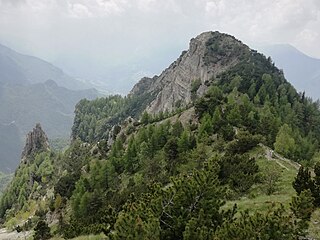
Monte Corno Battisti, previously known as Monte Corno or Corno di Vallarsa, is a mountain of Trentino, Italy, with an elevation of 1,778 metres (5,833 ft). It is part of the Pasubio massif in the Vicentine Alps, in the Province of Trento.


























